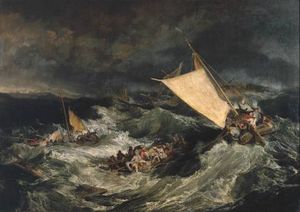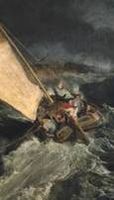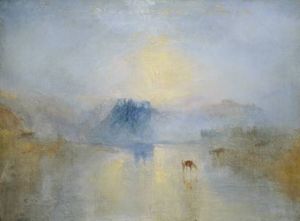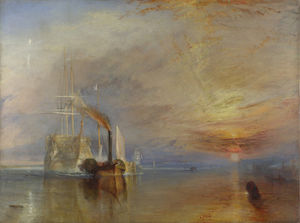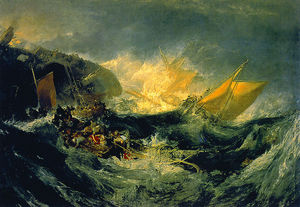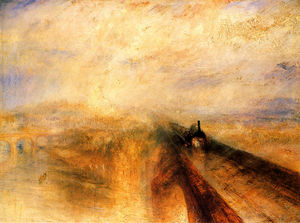The Shipwreck
- Date of Creation:
- 1805
- Height (cm):
- 170.50
- Length (cm):
- 241.60
- Medium:
- Oil
- Support:
- Canvas
- Subject:
- Landscapes
- Framed:
- Yes
- Art Movement:
- Romanticism
- Created by:
- Current Location:
- London, United Kingdom
- Displayed at:
- Tate Britain
- Owner:
- Tate Britain
- The Shipwreck Page's Content
- Story / Theme
- Inspirations for the Work
- Analysis
- Critical Reception
- Related Paintings
- Artist
- Art Period
- Bibliography
The Shipwreck Story / Theme
Dreadful catastrophe was a common theme in English romantic art period. The romantics had taken a liking to natural phenomena and shipwreck became a popular subject. 19th century Britain specifically was very familiar with shipwreck as it was a period of great English shipping. The Navigation Acts, the skill in English shipbuilding and the use of English oak made such trade possible. Still, the craftsmanship of these ships did not deter the fact that the man made vessel was still at the mercy of the wind.
Shipwreck may be regarded as one of the worst things a human being can encounter. The sea is no respecter of persons- instantly, 100s of men can be wiped out. Turner's fascination with man vs. nature is display in The Shipwreck. He wished to portray the power of the elements and how no one is immune from the dangers of an angry sea; he can struggle and fight but ultimately he will be swallowed up by the sea. The unlikelihood of deliverance from such calamity is great.
The Shipwreck:
Again she plunges! hark! a second shock
Bilges the splitting vessel on the rock—
Down on the vale of death, with dismal cries
The fated victims cast their shuddering eyes
In wile despair; while yet another stroke
With strong convulsions rends the solid oak.
-William Falconer (shipwreck survivor of the Britannia)
The Shipwreck Inspirations for the Work
From Turner's Notebook
"A brown picture which pervades thro' the water so as to check the idea of it being liquid... The chief light is upon the surge in the foreground-but too much is made to suffer-so that it is artificial-and shows the brown in a more glaring point of view and this inattention of the forms which waves make upon a lee shore embanked."
As a landscapist, Turner drew his greatest inspiration from nature itself. He was also inspired by fellow landscape artists, and from a trip he took to the Louvre.
Turner's ongoing fascination with the sea, and natural elements, is evidenced by The Shipwreck and his many other marine paintings. The power of the storm and man's subjectivity to such strength was a theme often visited and revisited by the artist. His love for the seaside is said to have begun in 1786 as he attended school in Margate. Throughout his lifetime he visited this English seaside town many times.
In 1802 Turner took a very influential trip to the Louvre. During this time he analyzed Dutch storm paintings that were on exhibition studying them closely and critiqued them carefully
The Shipwreck Analysis
Turner took his fascination of the sea and put it on canvas. In The Shipwreck his tone, brushstrokes, color palette and lighting all make up a beautiful composition to showcase the inferiority of man vs. the raging elements.
Composition:
Turner fills the canvas with the catastrophes of the sea and the main focus of calamity is towards the center of the canvas. One can feel the movement of the piece as the waves form deadly mountains, the broken ship on a peak, tilting towards the center where the crew awaits their failing destiny.
Tone:
The mood of this piece illustrates the calamity experienced during a shipwreck. Turner chose to exemplify the powers of the great sea compared to man's corruptible and very uncertain existence. One is reminded of true human frailty as they are powerless against the storm's anger.
Brush strokes:
The effectiveness of the lighting in this piece was achieved through Turner's light brush stroke. He has a quick but focused movement, as evidence by the realism of the crashing waves.
Color Palette:
The blues of the sky and the sea that encompass most of the canvas draw attention to the main action of the piece, the browns that make up the struggling ship. The overall color of this piece is subdued, the brightest element is the struggling, but shining sail.
Lighting:
As this painting was completed during his early years, Turner has still laid out the details of the elements in the painting. He pays a great deal of attention to his love of lighting in this piece, though not as heavily as his later paintings. The dark sky partners with the dark and furious sea contrasting against the yellow of the sail. The sail is the only object that draws the attention of light. As the sky is dark and gloomy, one wonders the light source the highlights the sail.
The Shipwreck Critical Reception
Turner was very fortunate when it came to critical reception of his work. The majority of his work was favored by critics, his shipwreck paintings were of no exception. The Shipwreck and other marine life works received much positive feedback from critics.
Contemporary Reception:
Shipwreck, a subject familiar to Turner, was a favorite among his critics. Of one of his shipwreck paintings, Sir George Beaumont said it was "the most awe-inspiring struggle of man and ocean yet depicted. " W. L. Wyllie, leading marine painter 50 years prior, said of another shipwreck painting that it "is the most splendid sea piece that has ever been painted; the power of the waves and the littleness of man have never been so magnificently suggested... the whole scene is one of death and horror.¨
Posthumous Reception:
Turner's shipwrecks were admired after his death but did not receive as much attention as his later works, such as the Norham Castle, Sunrise and The Fighting Temeraire.
Modern Day Reception:
Turner's shipwreck paintings continue to fascinate modern day audiences.
The Shipwreck Related Paintings
The Shipwreck Artist
J. M.W. Turner began his artistic career at a very young age. His success was fairly immediate, selling his first painting at just 12 years old. He continued to accomplish significant achievements at a remarkably young age and throughout his career he remained highly sought-after and acquired a very large fortune from his commissions. He is remembered as an influential painter, said to be the best landscapist of the 19th century, and a key artist to influence the Impressionist movement. Turner is famed for his original interpretations of bringing light and color to his canvases.
Turner submitted The Shipwreck to the Royal Academy in England in 1805 at the age of 30. By this time he had already become a full academician at the Academy, an astonishing achievement at such a young age. The Shipwreck is an early example of his love for the seaside, which began around 1786 while he studied in Margate (a seaside town in England). Throughout his lifetime he visited this English seaside town many times.
Shipwreck, a subject familiar to Turner, was a favorite among his critics and were admired after his death but did not receive as much attention as his later works, such as the Norham Castle, Sunrise and The Fighting Temeraire.
The Shipwreck Art Period
Romanticism is sometimes viewed as a reaction to its more serious predecessor, the Neoclassical movement. As Neoclassical artists focused on properly accounting history through close attention to detail, Romantic artists flirted with themes of man's self glorification, man's part in nature, divinity found in nature, and emotion. Though Neoclassicism is generally associated with the history genre, Turner is credited with having embarked upon a subject matter so great that it actually rivaled the history genre. His subject matter accounts for recording history, but in a different style than ever seen before. He used color as an intensity of emotion to portray the passing of events.
The Shipwreck Bibliography
Find out more about Turner and his works.
Books:
• Brennan, Matthew. Wordsworth, Turner, and Romantic Landscape. Columbia, SC. : Camden House, 1987
• Gage, John. Color in Turner: Poetry and Truth. New York: Frederick A. Praeger, 1969
Recommended Readings:
• Gaunt, William. Turner. Oxford: Phaidon Press, 1971
• Lindsay, Jack. J. M. W. Turner: A Critical Biography. London: Cory, Adams and Mackay, 1966
• Turner, J. M. W. The Shipwreck. 1805

